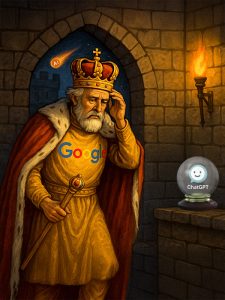At DuckByte, we love emerging technologies. I mean—we can nerd out on them all day…
We’ll happily fall down a rabbit hole about SEO and structured data while sipping coffee like it’s a cosmic event. But we also know our clients come to this world with… let’s call it a wide spectrum of enthusiasm.
Some love the shiny tech.
Some are terrified of the shiny tech.
Most are somewhere in the middle, like:
“I know I need this… I just don’t want to think about it too hard.”
That’s where we come in.
 We monitor the market, study the flashy new trends, and—most importantly—distinguish the fluff from the stuff that’s actually going to matter six months from now. Then we integrate what genuinely makes sense into our content writing, website builds, and SEO offerings so our clients stay ahead without having to become full-time tech philosophers.
We monitor the market, study the flashy new trends, and—most importantly—distinguish the fluff from the stuff that’s actually going to matter six months from now. Then we integrate what genuinely makes sense into our content writing, website builds, and SEO offerings so our clients stay ahead without having to become full-time tech philosophers.
So let’s talk about the thing that’s actually making Google sweat through its pressed shirt: ChatGPT.
Yes, Google is sweating.
Visible brow. Tiny towel. The whole thing.
From boardroom to throne room, the pressure is showing.
ChatGPT isn’t just “that little AI tool everyone’s playing with” anymore.
It’s rising so fast it’s basically skipping steps.
And here’s where things get interesting:
People are increasingly using ChatGPT the way they used to use Google — as a search engine.
But instead of clicking through ten links looking for the right info, they’re asking ChatGPT to do the digging: summarize, interpret, compare, prioritize, and then offer the top links to click. In other words, people aren’t just searching — they’re using AI to search, sort, filter, compare, and synthesize information—turning what used to be a multi-step process into a single, almost instant moment of clarity.
So is ChatGPT replacing Google outright? Not yet.
But the trend line is unmistakable—this is where user behavior is headed, quickly.
And Google knows it.
Which is why it recently narrowed how many of its search results ChatGPT is allowed to scan—from the top 100 down to the top 10.
That’s not just a technical tweak.
That’s Google tugging at its collar.
That’s Google saying: “We feel this.”
When the old king starts pacing the castle walls at night, you know the new era has begun.
And then the real plot twist dropped: ChatGPT launched its own browser.
Yes.
Its own browser.
 Enter Atlas—a full AI-enhanced browsing experience. And because the universe enjoys dramatic timing, this launch happened alongside an actual comet in the sky named, you guessed it… Atlas.
Enter Atlas—a full AI-enhanced browsing experience. And because the universe enjoys dramatic timing, this launch happened alongside an actual comet in the sky named, you guessed it… Atlas.
Coincidence? Probably.
Will DuckByte absolutely mention it anyway?
Of course.
Because that’s our charm:
We disarm the intimidating stuff with wonder, humor, and the occasional cosmic wink.
It makes things memorable.
It makes things human.
And it helps people ease into this new landscape with curiosity instead of dread.
But the important part is this:
Whether through Atlas or through the way people are already using ChatGPT to read the web for them,
AI-first browsing is no longer theory. It’s here.
And it changes how your website gets read.
So what does this mean for your website?
Good news: if you’ve already written clear content with solid headings, you’re ahead of the pack.
But now the game has changed.
If people are going to “browse” your website through ChatGPT—
meaning ChatGPT is the one reading, summarizing, and deciding what’s important—
your content needs to be structured in a way that teaches the AI:
“This is what this page is.
This is what matters.
Show this first.
Don’t get confused.
Here’s the meaning.”
That’s where Schema Markup comes in.
Think of it like SEO for the AI age—it’s how your website tells ChatGPT exactly what to say about you.
You know those little preview snippets you see in Google? Schema helps AI generate the same kind of clarity—so your business shows up with purpose, not guesswork.
And here’s the reality check: if your website doesn’t offer that kind of clarity, AI may not even surface it at all. You won’t just be misunderstood—you’ll be invisible.
And yes, “schema markup” sounds like a term invented by robots trying to unionize. But it’s really just structured clarity tucked away inside the code—a way to make sure your message comes through loud and clear, whether it’s being read by a person, a bot, or a browser with a name like Atlas.
And in a world where AI is doing more of the interpreting, meaning matters more than ever.
Here’s where DuckByte shines.
This new landscape isn’t scary for us—it’s thrilling.
We’ve been building for clarity, story, and structure long before “AI-first browsing” had a name.
DuckByte creates websites that:
- read beautifully to humans,
- translate perfectly to AI,
- and hold their shape whether a person or a chatbot is doing the browsing.
We handle Schema Markup so you don’t have to touch it.
We shape your content so AI can’t misinterpret it.
We design your pages so your message comes through clearly in this new AI-interpreter era.
This is the new world of SEO—and we’re already building for it.
Let us weave the structure, clarity, and Schema your website needs
so you can show up beautifully in both the human internet
and the ChatGPT-powered one that’s landing fast.

When the old king starts pacing the castle walls at night, you know the new era has begun.


